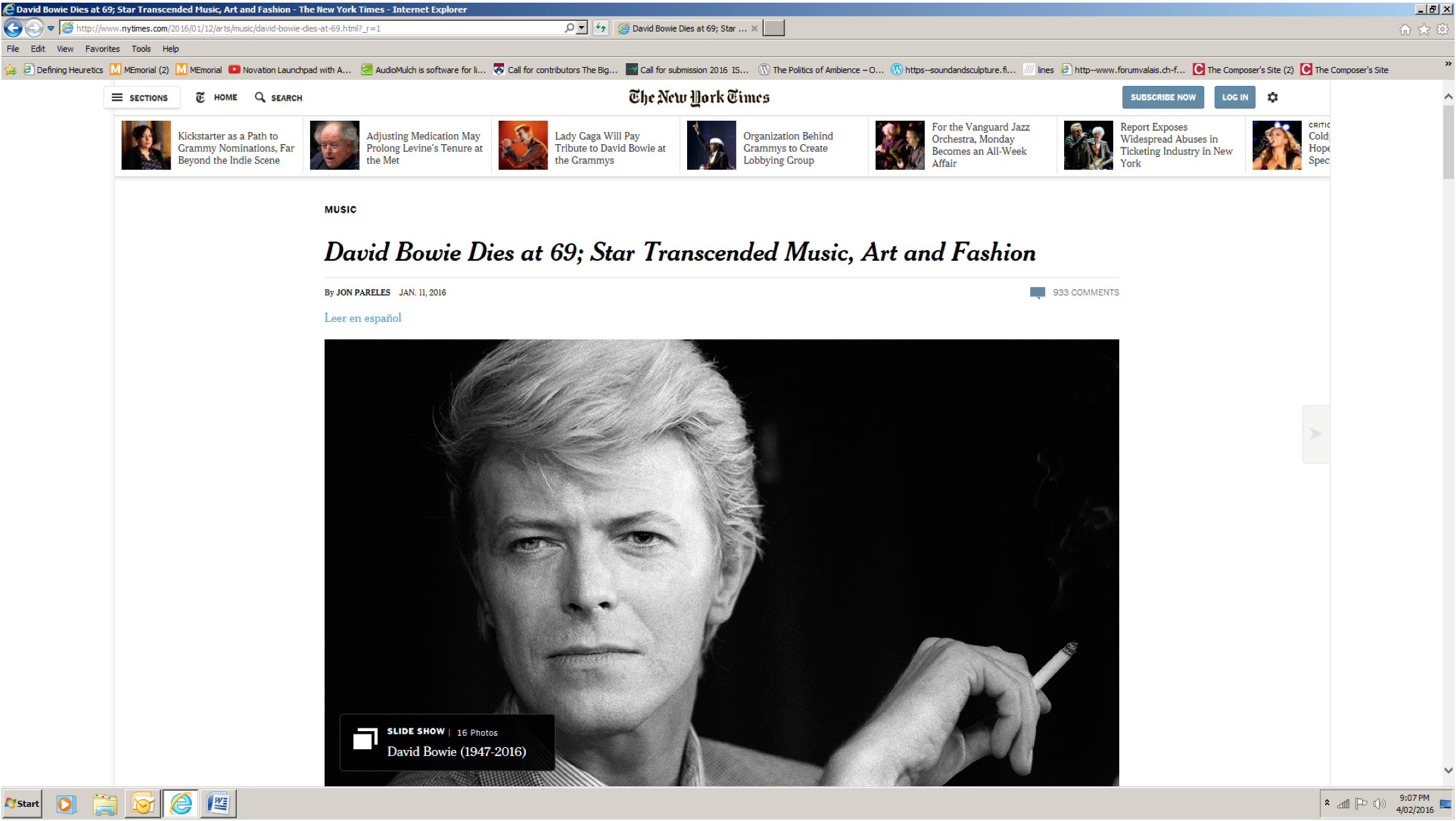David Bowie Metadata: A Chance Encounter with Online Mourning
David Prescott-Steed
1. Blackstar
Tuesday January 12, 2016: I go online to visit the David Bowie webshop. His latest album Blackstar was released four days ago and I want to see if the special editions CD's with the lithograph print are back in stock. I type ‘Bowie' into the Google search engine and the headline quickly appeared “David Bowie dies, aged 69." I am in shock and call out the awful news to my wife who is sitting in the other room. I can't believe that Bowie is gone. We are in shock. Ever since the video for ‘Blackstar', the album's title track was viewable on Vevo, I have watched it almost every day, excited about the prospect of a new era of activity for an artist who I have admired for over 30 years.
2. Bowie Is
Last year, the Victoria and Albert Museum in London held a retrospective exhibition of Bowie's life called “David Bowie Is." As part of the exhibition's international tour (to Chicago, Paris, Groningen, Berlin, among others), from July 16th to November 1st it was hosted by the Australian Centre for the Moving Image (ACMI) here in Melbourne. I was fortunate enough to see the exhibition—three times. The first two times were both in one day; one of the theory units I teach to tertiary level design-arts students has a component on counter-culture and fashion. As well as looking at the punk and Hippy movements, we took Bowie as a key case study in style that challenged various societal norms—gender representation/representations of masculinity, recreational, illicit drug use, general Western interest in outer space (the United States of America's space race with the Soviet Union (the freedoms of capitalism versus the hardships of enforced communism). I was responsible for two classes that, due to complex student timetables, could not be amalgamated for the sake of an excursion. On October 10, I had one group in the morning and one in the afternoon. It was a day of total bliss. A few days later, I returned with my wife and three year old daughter, who danced her way around the exhibition and hugged a large portrait poster of Bowie that had been placed outside the building.
3. Ego-ideal
For me, Bowie was/still is something of an ‘ego-ideal.' Laura Mulvey explains the ego-ideal in Visual Pleasure and Narrative Cinema (382).
“The mirror phase occurs at a time when the child's physical ambitions outstrip his motor capacity, with the result that his recognition of himself is joyous in that he imagines his mirror image to be more complete, more perfect than he experiences his own body. Recognition is thus overlaid with misrecognition: the image recognised is conceived as the reflected body of the self, but its misrecognition as superior projects this body outside itself as an ideal ego, the alienated subject which, re-introjected as an ego ideal, gives rise to the future generation of identification with others. This mirror-moment predates language for the child."
Bowie was in the public eye ever since I was born. There are many different Bowie's. His capacity for self-reinvention meant that he presented as something of an ego-ideal for me. In this sense his death can be thought of, at least in part, as a form of ego death—in John Harrison's (2010) sense of a “loss of the separate self."
Yet, if anything, his image has been projected more than ever before, since the news was announced. His legacy lives on in digital projections. But they are empty binary—no more than zeros and ones on the screen. It reminds me of a story Sartre tells in Being and Nothingness, about waiting in a café for someone by the name of Pierre. Sartre is expecting Pierre to arrive at any moment but nothing happens; Pierre doesn't show up. Pierre should be there, or at least Sartre expects him to be Instead, Sartre is left to ponder the empty chair in front of him. In that disappointment—the grounds upon which “Pierre is given as about to appear" (41)—Sartre catches a glimpse into nothingness. café. “[M]y expectation has cause the absence of Pierre to happen," says Sartre (42). At this point, Sartre's experience of the café is fixed in nothingness; an unfathomable abyss.
The new era of Bowie that I thought we were about to witness will not happen. There is a hole where a whole once seemed to have always been. Bowie knew he was one of many stars, even if he was confident that he had achieved something truly remarkable—irreplaceable. I believe that the lyrics of ‘Blackstar' suggest this in two ways:
a) “Somebody else took his place, and bravely cried. I’m a blackstar, I’m a blackstar." The notion of the supplement is here, i.e. the king is dead, long live the king.
b) “You’re a flash in the pan (I’m not a marvel star). I’m the great I am (I’m a blackstar)" Bowie's multifaceted career lasted 54 years; he was no-one's one-hit wonder, proud of the fact, and rightly so.
4. Aleatoric Writing
The Verbasizer was developed by Ty Roberts in the early 90s following his visit to see David Bowie and Brian Eno at their studio. Bowie and Eno had been using cut-up techniques to produce lyrics and ideas. ‘Cut-up' is an experimental strategy for text production that dates back to the Dada art movement, and was made popular through the works of beat-generation writer William Burroughs in the 1950s and 60s. To perform a cut-up, one or more pieces of writing are cut into pieces. The decontextualised parts can then be shuffled indefinitely to create new sentences and, ultimately, a new text that may contain surprise juxtapositions and unexpected meanings. Observing this, Roberts went on to develop software, to be called the Verbasizer, that would enable Bowie to speed this process up, particularly useful when working with online text sources. Bowie discusses the Verbasizer in the 1997 film Inspirations, directed by Michael Apted, which looks at the creative processes of several prominent figures in the arts:
“Well it’s a program that I developed with a friend of mine in San Francisco, and it’s called the Verbasizer.”
“It’ll take the sentence, and I’ll, I’ll divide it up between the columns. And when I’ve got say three or four or five– sometimes I go as much as twenty, twenty-five sentences. Going across here.”
“And then I’ll set it to Randomize.”
“And it’ll take those twenty sentences and cut in-between them all, all the time picking out, choosing different words from different columns. And from different rows of sentences. So what you end up with is a real kaleidoscope of meanings and topics and nouns and verbs all sort of slamming into each other.”
“The choices that I now make from this form, I can then reimbue it with an emotive form if I want to. Or, take it as it writes itself."
Bowie often used newspaper headings and content for his adventurous juxtapositions. They resulted in fractured reflections of current events as well as providing inspiration for other lyrical pathways, found most notably in the album Outside (1995). We can see that the cut-up strategy, in large part, attempts to side-step the creative ego of the artist, i.e. the unique expression of an individual personality. Chance interferes with the artist's hand, confounding his or her will, which can be said to effect its own fleeting ego death.
5. Keeping Busy
David Bowie's final studio album is widely understood to be a farewell to his listeners. My sadness at Bowie's death is not unique. How strange it is that so much can be felt for someone I never met. Perhaps it is pointless to try an understand the sense of it all, particularly in view of the vast number of news media reports that have flooded cyber space over the past few weeks. It's important to be active in the meaning making process, active when reading a text, as outlined in Roland Barthes “Death of the Author": “The removal of the Author…is not merely an historical fact or an act of writing; it utterly transforms the modern text (or - which is the same thing - the text is henceforth made and read in such a way that at all its levels the author is absent)" (145). When putting together the pieces of the present news-media puzzle, the reader must be content with adopting a forensic approach to the construction of narrative meaning, just as if one were edging through a work by Alain Robbe-Grillet (for example ‘In the Labyrinth', ‘Jealousy', or ‘Repetition').
It seemed appropriate to pursue a synthesis of the pieces in front of me—death, cut-up technique, tributes expressed online, pictures from Bowie's private and professional life, of the flowers piled high outside his Soho building—a veritable Baudrillardian hyperreality of mourning currently being narrated and mediated by the papers in (not only) binary form. This negotiation of the growing electronic memorial to Bowie connects directly to Greg Ulmer's theory of MEmorials—creative problem solving approaches to the monitoring of a loss of some kind. MEmorials are citizen-centric, electrate practices that challenge the tradition function of the memorial as a progenitor of closure by “mak[ing] it possible for monumentality to go ‘live'" (Ulmer, Electronic Monuments (Electronic Mediations) xxi). Applying Ulmer's terms, this MEmorial does not confirm or deny a social investment in Bowie, but recognizes him “as a specific kind of value, belief, commitment, with the purpose of helping the public understand itself in its collective identity" (Ulmer, Electronic Monuments (Electronic Mediations) 50).
Ulmer's theory offers insight into what this kind of ‘keeping busy' might be, but how might a chance encounter with online mourning unfold? Ulmer is valuable here also, specifically with regard the method of invention that he calls heuretics. Heuretics is a method that “becomes invention when it relies on analogy and chance" (Arroyo 112). As Ulmer defines it, “‘heuretics' refers to the use of theory for the invention of new texts (poetics of any sort)" (Ulmer, “Heuretics: Inventing Electracy" np). These new texts allow us “to understand something while also participating in its invention. Heuretics serves as the methodology for participatory composition" (Arroyo 112).
With theory driving practice, I decided to take the following creative/ experimental course of action. My original intention was to feed numerous online news reports of Bowie's death, with all their assumptions and conclusions, into a Verbasizer—to slam the attempted closures of these online memorials against each other. It seemed important to try and access a sense-making space beyond the very kind of mass mourning that has seen retail outlets sell out of Bowie merchandise, that has seen his work reach number 1 in the US for the first time in his career, despite having lived and worked there for over twenty years (i.e. an exit strategy from the media-circus). Rather than further feed on death, I wanted to digest it and create something else. That is, I wanted to pursue/construct a responsive language somewhere beyond a (digitally mediated) mourning (and be open to further processing and regeneration and that, therefore, poses its own challenge to death). Ulmer recognizes the contribution of heuretics to what Barthes called “‘the return of the poetician'—one who is concerned with how a work is made.' This concern does not stop with analysis or comparative scholarship but conducts such scholarship in preparation for the design of a rhetoric/poetics leading to the production of a new work" (Ulmer, Heuretics: The Logic of Invention 4). I'd like to think that Bowie would have appreciated news reports of his passing being used as grist for the very kind of experimental text-mill that he used in his work; using them in a language game that he valued and, just as importantly, one that he employed as a creative communication tool.
In order to put this intention into practice, I copied the Bowie-related text from five online news articles and pasted them into a single word document. The articles are listed as follows:
“David Bowie Obituary", written by Adam Sweeting and published online by The Guardian on January 11:
http://www.theguardian.com/music/2016/jan/11/obituary-david-bowie
“David Bowie dies of cancer aged 69", author unknown, published online by BBC News on January 11:
http://www.bbc.com/news/entertainment-arts-35278872
“David Bowie Dies at 69; Star Transcended Music, Art and Fashion", written by John Pareles and published online by the New York Times on January 11:
http://www.nytimes.com/2016/01/12/arts/music/david-bowie-dies-at-69.html?_r=0
“David Bowie Dead at 69", written by Kory Grow and published online by Rolling Stone on January 11:
http://www.rollingstone.com/music/news/david-bowie-dead-at-69-20160111
“David Bowie dead: music legend dies at 69 after cancer battle", written by Iain Shedden and published online by The Australian on January 12.
http://www.theaustralian.com.au/news/world/david-bowie-dead-music-legend-dies-at-69-after-cancer-battle/news-story/a24a64251739139149ce41636d28ac29
The fact that the Verbasizer is not publicly available does not matter. There are various text-mashing tools available for free that fulfill the same function, albeit in digital counterpart, to the pre-digital, handwritten/manually handled cut-ups of the Dadaists, Surrealists, Burroughs, and Bowie, among others. In this instance, I chose to use an online text processor called Cut Up Machine, hosted by ‘Language is a Virus.com', found here:
http://www.languageisavirus.com/cutupmachine.html#.Vp7lwmeIqJA
I processed the text, copied and pasted the whole lot into another word document. I then read through this text for fragments that stood out from the rest, taking them as they wrote themselves. The final step was to extract these highlighted parts and compile them in a list, as in the form of a new cut-up poem. This poem is the result of my own experiment addressing one of the terms included on the Textshop Experiments website. “Bowie News Kaleidoscope" has resulted from my interest in the digital mediation of ‘mourning.'
6. Bowie News Kaleidoscope
personas reunited the Diamond artifice
musical privacy death
his guest sang of the cities
only a songwriter
restless Stardust frontman
songs returned hindsight
pictured psychedelia
Golden Earthling
hospital past well
Laughing
bagged glam-rock club hotel
nothing
style production
fearless
taking days dead
We have his music
recent soul
grief changing trends
Iman is in compositions
a Tom’s deathbed
grammar Smashing and Image challenging
and straight-up that floral Lazarus
well-received outsider
divided alien
the Heathen latest drawing
longer story sorry band
unhappiness sands
suffering in the baritone
online sang he
unhappiness
the Next David metamorphoses
and ever satisfying renown
metal of acting
Noise art
parting the archive
Temptation morphing mixing
Pretty Ziggy roles
drew voices on Tom
Bowie's monsters
in fashionable videos
thereafter grief
and the Temple's order
of salvaged experimentation
imitated apocalypse
with a wistful spectrum
He's earned the troupes
Bowie Man a stardom fan
fact cancer
theatrical Bowie
Mr. pop trail and his decked guitar
artist actor guitar
Blackstar
Sound movement metamorphoses
Times reinvention
Tin passed Bowie once you dance
Tom made Bowie grungy
the electronica of experiments
musical Memoriam
David Prescott-Steed is a sound artist, writer and urban explorer based in Melbourne. He is employed as an Academic Fellow at the Academy of Design Australia, teaching visual culture studies and art history to undergraduate design-arts students from a range of industry-led areas including graphic design, advertising, and photo-media. Recent publications include: “Intersections of Creative Praxis and Urban Exploration" (2015) in The Journal for Artistic Research (JAR), Issue 9, Bern, Switzerland, and “Invitation to Reading: Tactical Music in the Design-Arts Theory Classroom" (2015) in The Atrium: A Journal of Academic Voices.
References
Arroyo, Sarah J. Participatory Composition: Video Culture, Writing, and Electracy. Carbondale, IL: Southern Illinois University Press 2013. Print.
Barthes, Roland. “The Death of the Author." Trans. Stephen Heath. Image, Music, Text. London: Fontana Press, 1977. 142-7. Print.
Mulvey, Laura. “Visual Pleasure and Narrative Cinema." Visual Culture: A Reader. Ed. Jessica Evans and Stuart Hall. London: Sage, 1999. Print.
Sartre, Jean-Paul. Being and Nothingness. Trans. Hazel E. Barnes. New York: Washington Square Press, 1956. Print.
Ulmer, Gregory. Electronic Monuments (Electronic Mediations). Minneapolis: University of Minnesota Press, 2005. Print.
- - -. “Heuretics: Inventing Electracy". 2009. Blog. February 8 2016. <https://heuretics.wordpress.com/>.
- - -. Heuretics: The Logic of Invention. Baltimore: The Johns Hopkins University Press, 1994. Print.






